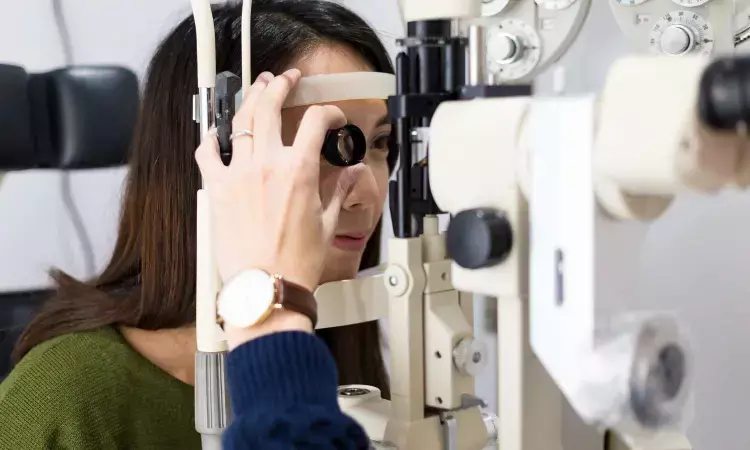- Home
- Medical news & Guidelines
- Anesthesiology
- Cardiology and CTVS
- Critical Care
- Dentistry
- Dermatology
- Diabetes and Endocrinology
- ENT
- Gastroenterology
- Medicine
- Nephrology
- Neurology
- Obstretics-Gynaecology
- Oncology
- Ophthalmology
- Orthopaedics
- Pediatrics-Neonatology
- Psychiatry
- Pulmonology
- Radiology
- Surgery
- Urology
- Laboratory Medicine
- Diet
- Nursing
- Paramedical
- Physiotherapy
- Health news
- Fact Check
- Bone Health Fact Check
- Brain Health Fact Check
- Cancer Related Fact Check
- Child Care Fact Check
- Dental and oral health fact check
- Diabetes and metabolic health fact check
- Diet and Nutrition Fact Check
- Eye and ENT Care Fact Check
- Fitness fact check
- Gut health fact check
- Heart health fact check
- Kidney health fact check
- Medical education fact check
- Men's health fact check
- Respiratory fact check
- Skin and hair care fact check
- Vaccine and Immunization fact check
- Women's health fact check
- AYUSH
- State News
- Andaman and Nicobar Islands
- Andhra Pradesh
- Arunachal Pradesh
- Assam
- Bihar
- Chandigarh
- Chattisgarh
- Dadra and Nagar Haveli
- Daman and Diu
- Delhi
- Goa
- Gujarat
- Haryana
- Himachal Pradesh
- Jammu & Kashmir
- Jharkhand
- Karnataka
- Kerala
- Ladakh
- Lakshadweep
- Madhya Pradesh
- Maharashtra
- Manipur
- Meghalaya
- Mizoram
- Nagaland
- Odisha
- Puducherry
- Punjab
- Rajasthan
- Sikkim
- Tamil Nadu
- Telangana
- Tripura
- Uttar Pradesh
- Uttrakhand
- West Bengal
- Medical Education
- Industry
Higher STOP-BANG Scores Linked to Increased Intraocular Pressure among elderly: Study

A higher value of STOP-BANG score defines a higher risk of occurrence of obstructive sleep apnea (OSA). A higher degree of STOP-BANG has a positive association with increasing intraocular pressure (IOP) in a Korean adult population aged at least 40 years. Intraocular pressure is recognized as a major risk for glaucoma, which is one of the causes of vision loss among patients. A recent study was conducted by Kim and Lee published in the Journal of Glaucoma.
The study determines the association of intraocular pressure with the risk of obstructive sleep apnea among Korean adults. The primary aim was to establish whether subjects with higher STOP-BANG scores or symptoms of OSA would have a greater chance of having an elevated IOP.
This was a population-based, cross-sectional study of adults aged 40 years or older based on the Korea National Health and Nutrition Examination Survey VIII database. The sample included 6,315 subjects between 2019 and 2021. Assessments of the risk for OSA were performed by using the STOP-BANG questionnaire, and IOP measurements were obtained by a rebound tonometer. The relationship of STOP-BANG score to the top IOP quartile is established, adjusted for lifestyle, age, sex and diabetes status through logistic regression analysis.
• Those having STOP-BANG scores from 3 to 8 had a higher odds ratio of increased IOP, by 1.27 times compared with those scoring between 0 and 2 (95% CI: 1.12-1.43).
• Among the STOP-BANG factors, loud snoring, witnessed apnea, high blood pressure, and large neck circumference were associated with a 24% to 40% increased risk of IOP elevation compared with patients without these factors.
• All four together were associated with an increase of more than a twofold of the relative risk of having high IOP compared to those with no risk factors at all (OR 2.09; 95% CI: 1.26-3.46).
In conclusion, this study strongly links high STOP-BANG scores to increased IOP in people aged 40 and older. Individual OSA risk factors such as loud snoring, observed breathing interruptions, hypertension, and wide neck circumference were significantly associated with increased IOP both as single and in combination risk factors. The findings call for the control of symptoms of OSA to lower the risk of increased intraocular pressure and its sequelae on the eye.
Reference:
Kim, J. L., & Lee, K. (2024). Association between risk of obstructive sleep apnea and intraocular pressure based on the Korea National Health and Nutrition Examination Survey VIII. Journal of Glaucoma. https://doi.org/10.1097/IJG.0000000000002512
Dr Riya Dave has completed dentistry from Gujarat University in 2022. She is a dentist and accomplished medical and scientific writer known for her commitment to bridging the gap between clinical expertise and accessible healthcare information. She has been actively involved in writing blogs related to health and wellness.
Dr Kamal Kant Kohli-MBBS, DTCD- a chest specialist with more than 30 years of practice and a flair for writing clinical articles, Dr Kamal Kant Kohli joined Medical Dialogues as a Chief Editor of Medical News. Besides writing articles, as an editor, he proofreads and verifies all the medical content published on Medical Dialogues including those coming from journals, studies,medical conferences,guidelines etc. Email: drkohli@medicaldialogues.in. Contact no. 011-43720751


